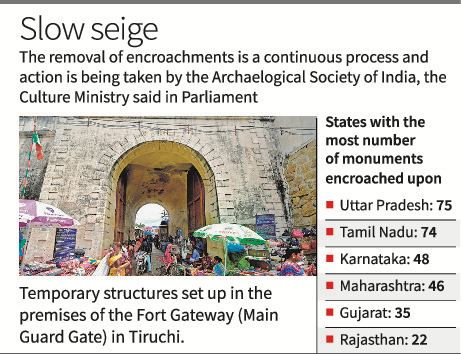Description

Copyright infringement is not intended
Context: A total of 356 heritage structures have encroachments across the country, Tourism and Culture Minister Kishan Reddy told the Rajya Sabha.
Details:
- Uttar Pradesh has the largest number of Centrally Protected Monuments that have been encroached upon, closely followed by Tamil Nadu.
- Uttar Pradesh also has the largest number of Centrally Protected monuments in the country at 743, while Tamil Nadu has 412.
- A total of 356 such heritage structures have encroachments across the country.
- India has a total of 3,695 Centrally Protected Monuments or Sites in the country, under the protection of the Archaeological Survey of India (ASI).
- The monuments are regularly inspected by the ASI officials to assess their present condition. Necessary conservation and preservation works are taken up as per the requirement.
- The ASI regulates construction around the protected monuments through the Ancient Monuments and Archaeological Sites and Remains (Amendment) Act, 2010. The Act prohibits construction within 100 metres of a protected monument.
- The next 300-metre radius is regulated too. Proposed amendments seek to do away with the ban on construction within 100 metres of a monument and only regulate construction within 100-200 metres, under the Act that protects monuments and sites over 100 years old.
- This is expected to give more powers to the ASI on the encroachments.
.jpg)
Ancient Monuments and Archaeological Sites and Remains (AMASR) Act 1958:
- The Act was introduced for safeguarding the cultural heritage of the country.
- The main objective of the act is to protectancient and historical monuments and archaeological sites and remains of national importance.
- The act also regulates the archaeological excavations and the protection of sculptures, carvings and other like objects.
- The Archaeological Survey of India functions under the provisions of this act.
- The Act was amended in 2010to strengthen its penalty provisions, to prevent Encroachments and illegal construction close to the monuments.
- No Construction was permitted in an area around 100 meters of national monuments. 200 m beyond that is declared as a “regulated area”.
- The amendment also introduced heritage bye-laws for each monument to be prepared by an expert body.
- The Act was again amended in 2017:
- The Union Government can extend the prohibited area beyond 100 meters of National Monuments.
- No construction in prohibited areas, except under certain conditions.
- Earlier no construction was permitted in ‘prohibited areas’ even if it is for public purposes.
- The 2017 amends this provision to permit construction works in ‘prohibited areas’ for public purposes.
- If there is any question related to a construction project that qualifies as ‘public works, it will be referred to the National Monuments Authority. It will recommend to the Union government.
- The decision of the Union government will be final.

https://epaper.thehindu.com/Home/ShareArticle?OrgId=GK3AM06QE.1&imageview=0






